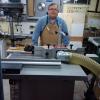
Originally Posted by
Edwin Santos

Hello John,
Have a look at this video from FWW and Michael Fortune and you will no longer be able to make your second statement above. Of course whether you agree with it or not will be your call.
https://www.youtube.com/watch?v=vNdrkmx6ehI
I've had the privilege of taking a class with Michael Fortune and he really deserves to be called a master woodworker in every respect. Following his bandsaw tuning guidelines and sawing techniques has eliminated drift from my life and taken my bandsawing to a much higher level. This was despite my skepticism while he explained it.
Not trying to start a fight with the fans of co-planarity, just reporting that Michael's procedures worked very well for me.
Edwin
You got me, Edwin. Yes, of course you have to adjust the table parallel with the blade, exactly once as Michael Fortune so perfectly explained. I had to do exactly that both with my old 14" Delta and also with my new Grizzly since I had to take the table off that one, along with a lot of other parts, to get it down into my basement shop. But it's a one time thing.
Hallelujah, Fortune as part of this process explains why adjusting for drift is completely unnecessary. I'm sure the companies that make the Driftmaster type fences were very pleased! But he's absolutely right. If you want to use the miter slot you have to have a blade that cuts straight and parallel with the miter slot, and once you have that there's no need to skew the fence.
You'll note that Fortune never mentioned anything about wheel alignment, nor would he if the saw was new and/or in good operating condition. I'd be interested in his approach, however, if he had my 14" Delta in the condition I started with.
I would love to take a class with Michael. He is one of the writers I respect most.
John





 Reply With Quote
Reply With Quote





